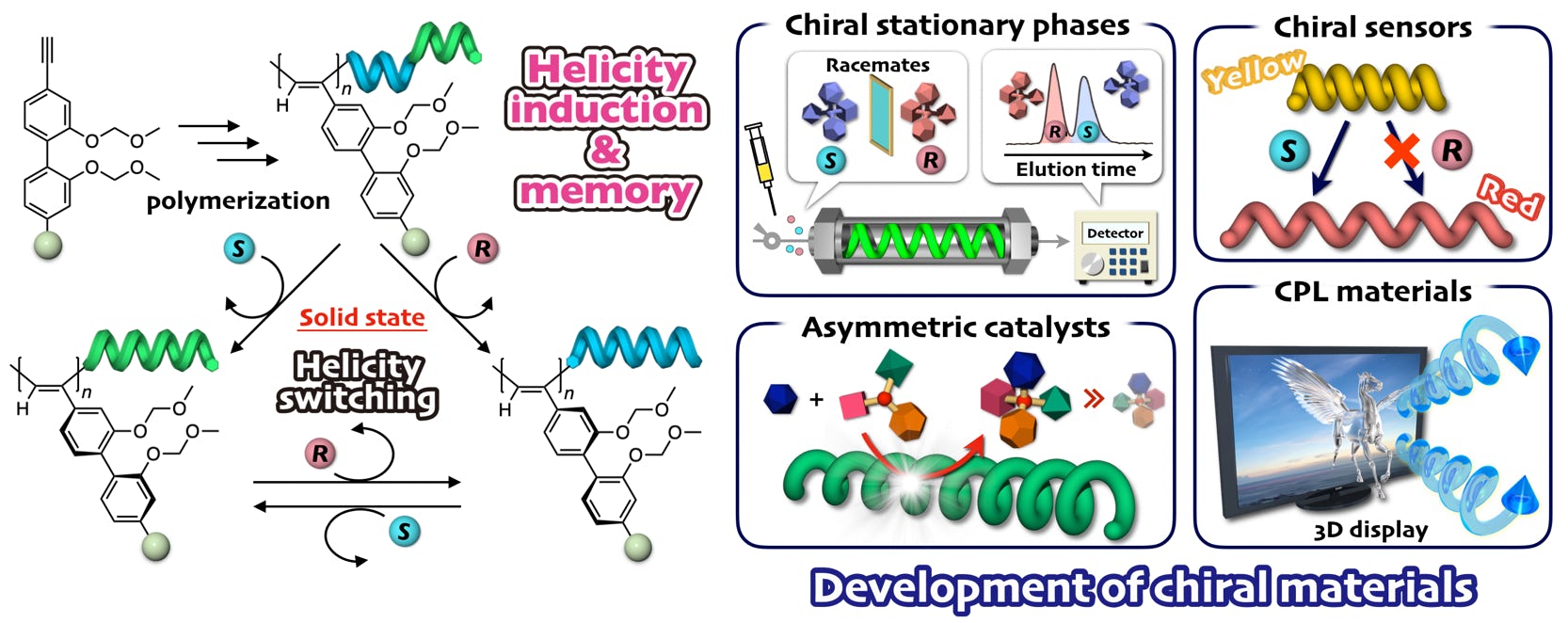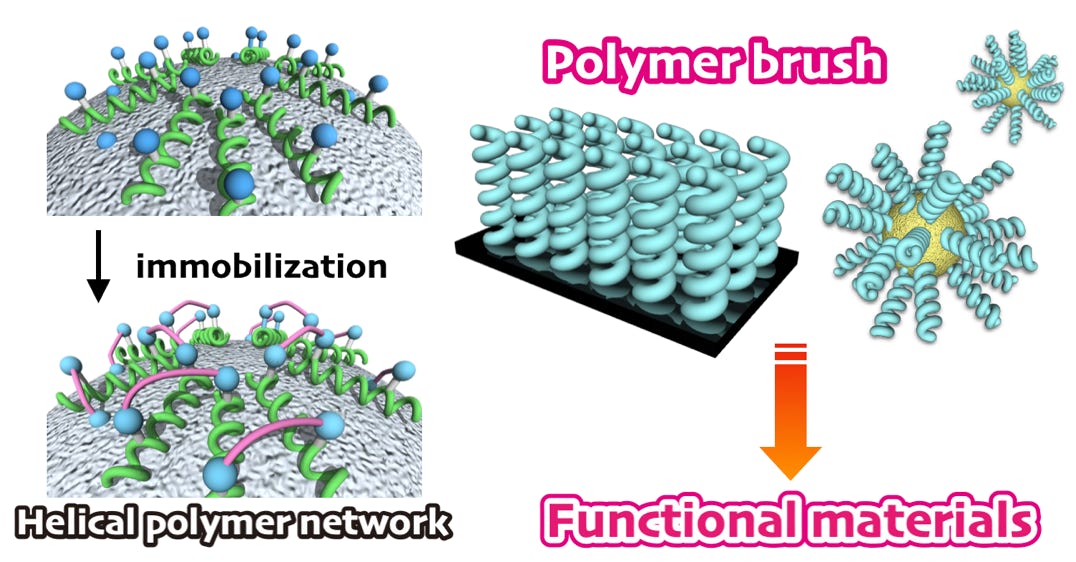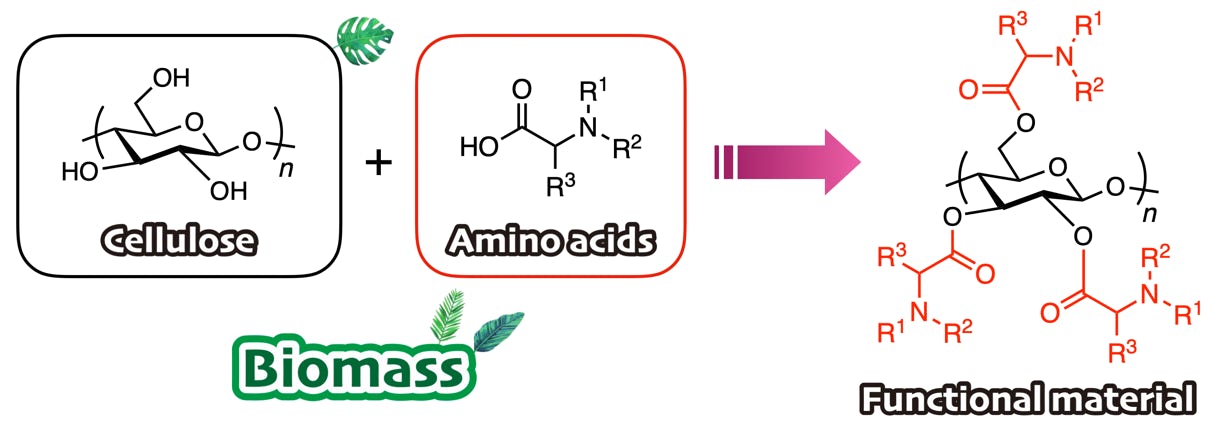In our “Synthetic Polymer Chemistry Laboratory”, we are continuously working to promote the development of new functional polymeric materials and their applications. Presently, we are mainly working on following five different research projects “Functional Polymer”, “Polymer Synthesis”, “Surface Science”, “New Reaction” and “Bio-Based Material”. For details please check the following explanation sections.
Topics
Functional Polymer: Investigation of the function of artificial helical polymers and their application to chiral materials
The development of artificial helical polymers exhibiting unique and advanced functions has drawn major research attention because of its versatile applications. Recently, our group has reported that polyacetylenes containing unique pendant groups in the side chain formed predominantly one-handed helical structures (left- or right-handed) in the presence of chiral guests (R or S), and the induced helical conformation was automatically memorized even after complete removal of chiral guests. This unique helicity induction and memory phenomena were confirmed even in the solid state and applied to the unprecedented elution order switchable chiral column for enantioseparation of chiral compounds. Furthermore, we have developed chiral sensors detectable even hidden chirality, chiral recognition ability-switchable chiral column by addition of a catalytic amount of metal salts, and fluorophore exhibiting circularly polarized luminescence derived from a small amount of chiral compounds. Research projects regarding the development of chiral materials such as asymmetric catalysts with chiral amplification, and information memorable materials based on the function of the helical polymers are currently in progress.

Related papers:
· Nat. Chem. 2014, 6, 429–434.
· J. Am. Chem. Soc. 2019, 141, 8592–8598.
· J. Am. Chem. Soc. 2020, 142, 3254–3261.
· Sci. Adv. 2021, 7, eabg538
· J. Am. Chem. Soc. 2018, 140, 3270–3276.
· Chem. Commun. 2019, 55, 7906–7909.
· J. Am. Chem. Soc. 2020, 142, 7668−7682.
· Chem. lett. 2023, 52, 136–139
Polymer Synthesis: Development of new methods for the polymerization of substituted acetylenes and their application to highly functional materials
Polyacetylenes are important π-conjugated polymers and their rigid backbones form a helical conformation, which are promising as functional materials such as organic EL and chiral recognition materials. For practical application of polyacetylenes well control of molecular weight and easy modification of end functional groups are essential. In this context, only living polymerization can control the molecular weight of the polymer very preciously. However, in the literature very limited methods have been reported for the living polymerization of acetylene monomers unlike that of vinyl monomers. Inspired by rhodium-catalyzed reactions with organoboron compounds in organic synthesis, we have recently developed the living polymerization of phenylacetylenes with a rhodium-based multicomponent catalytic system. By exploiting the above technique different end functionalized poly(phenylacetylene)s have been synthesized with special structures, which are really useful for the preparation of new organic-inorganic hybrid materials.

It is well known that the polymerization of disubstituted acetylenes is not very effective due to their steric factors. In particular, there are only limited classical methods for the polymerization of diphenylacetylenes, and monomers having polar functional groups. We have recently developed an improved technique for the polymerization of diphenylacetylenes using a tungsten-based catalyst system. The polymerization mechanism and detail of the structure of the polymer have been studied systematically. Presently, we are working on the development of various well-controlled polymers of diphenylacetylenes.
Related papers:
· Angew. Chem. Int. Ed. 2020, 59, 8670–8680.
· J. Am. Chem. Soc. 2021, 143, 16136-16146.
· J. Am. Chem. Soc. 2021, 143, 3604–3612.
· Angew. Chem. Int. Ed. 2023, e202302332
Surface Science: Science of helical polymers on material surfaces
Artificial helical polymers show unique structural changes such as elongation and inversion in addition to amplification, memory and transmission of chiral information. However, the behavior of the helical polymer on the solid surface is still not very clear due to the problem of preparation, measurement and evaluation methods, compared to the behavior in solution or in solid state. The elucidation of surface chemistry of the helical polymer has the potential to change the common sense of helical polymer-based materials. As shown in the section “Functional Polymer”, our group has reported elution order switchable chiral column for enantio-separation of chiral compounds. The immobilization of helical polymers onto the silica-gel improves solvent durability, whereas conventional immobilization technique restricts the mobility of helical polymer. Recently, we have developed a novel immobilization method of polymer using covalent bonding network on the silica gel surface but without compromising with the mobility of the polymer. Furthermore, the mobility of helical polymer on the solid surface was clarified by using their chiral recognition ability as the evaluation factor. Research projects regarding the development of a surface modification based on a novel polymerization technique is represented in the section “Polymer Synthesis” and collaborative work is going on with other research teams having expertise in AFM measurement.

Related papers:
· Polym. Chem. 2017, 8, 4190–4198.
· Angew. Chem. Int. Ed. 2020, 132, 14779 – 14784.
· Polym. Chem. 2019, 10, 6260–6268.
· J. Chromatogr. A 2022, 1675, 463164.
New Reaction: Development of π-conjugated materials using highly reactive species
The synthesis of new monomers and invention of new polymerization technique are always important in the field of polymer research to develop new functional polymers. In this context, our research group continuously is working to develop new functional polymers/materials. Recently, we have successfully identified molecular transformation of polyfluoroarenes using boryl radicals and different boron-containing π-conjugated molecules have been synthesized by reacting boron-centered radicals with π-conjugated molecules such as phenylacetylenes or polyfluoroarenes. The newly developed boron-containing π-conjugated molecules are highly beneficial for their applications as liquid crystalline and light emitting materials.

Related papers:
· Org. Lett. 2020, 22, 2054–2059.
· Eur. J. Org. Chem. 2019, 37, 6308–6319.
· Angew. Chem. Int. Ed. 2018, 57, 9485–9490.
· Angew. Chem. Int. Ed. 2020, 59, 903–909.
· Angew. Chem. Int. Ed. 2019, 58, 6357–6361.
· Org. Lett. 2021, 23, 1071–1075.
Bio-Based Material: Development of functional materials using biomass compounds
In recent years, we have encountered global environmental problems to overcome, and polymer chemistry should contribute to such the problems. Cellulose is an abundant biomass material, but its application to highly functional materials has been limited due to problems in solubility and reactivity. We have recently developed new ion adsorption materials composed of cellulose and amino acid derivatives which are another biomass material. Collaboration work with other research groups is currently ongoing, and our goal is removal of hazardous substances from environment and efficient recovery of precious metals from waste.

Related papers:
· Biomacromolecules 2023, 24, 3767–3774
· RSC Adv. 2020, 10, 30238 – 30244.
· Chem. Sci. 2019, 10, 4890–4895.
· Polym. Chem. 2017, 8, 4190–4198.
· J. Hazard. Mater. 2019, 380, 120816.
· Polym. Chem. 2018, 9, 2109–2115.
· Polym. Chem. 2017, 8, 2257–2265.
Copyright©︎ 2020, Synthetic polymer chemistry lab., Kanazawa university.
All right reserved.